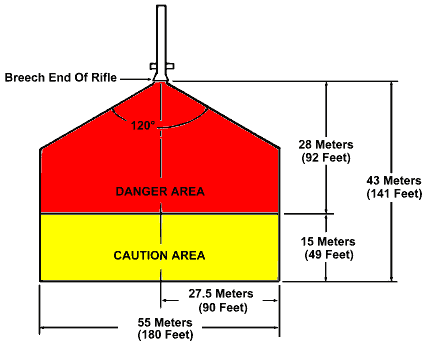The M67 90mm recoilless rifle is a lightweight, portable, crew-served weapon intended primarily as an antitank weapon. It can be
employed in an antipersonnel role too. It is designed to be fired primarily from the ground using the bipod and monopod, but it may
be fired from the shoulder. It is an air-cooled, breech-loaded, single-shot rifle that fires fixed ammunition. The rifle is equipped
with a manually operated breech mechanism and a percussion-type firing mechanism. It is designed for direct firing only, and sighting
equipment for this purpose is furnished with each weapon.
Replaced by the M47 Dragon missile in U.S. service.
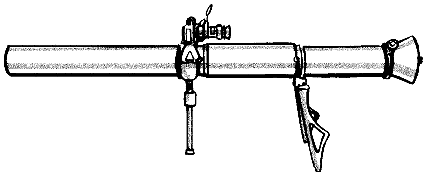
Cartridge case M112 is common to all 90mm recoilless rifle ammunition. It is an unperforated aluminum cylinder fitted at the base
with a plastic rupture disk. The case is 16.29 inches (414 mm) long and weighs 1.0 pounds (0.45 kg). The cartridge case is attached
to the projectile by a series of equally spaced ball crimps.
The projectiles used in these rounds are preengraved, that is, the rotating bands are cut to engage the rifled bore.
90mm recoilless rifle ammunition.
| Model |
Type |
Cartridge Weight |
Cartridge Length |
Projectile Weight |
Muzzle Velocity |
Maximum Effective Range |
Fuze |
| M371 |
TP |
9.25 lb (4.2 kg) |
28.10 in (714 mm) |
6.75 lb (3.06 kg) |
700 fps (213 mps) |
437 yd (400 m) |
PIBD M530A1 |
| M371A1 |
HE |
9.25 lb (4.2 kg) |
28.10 in (714 mm) |
6.75 lb (3.06 kg) |
700 fps (213 mps) |
437 yd (400 m) |
PIBD M530A1 |
| M590 |
APERS |
6.79 lb (3.08 kg) |
19.19 in (487 mm) |
3.97 lb (1.8 kg) |
1,250 fps (381 mps) |
328 yd (300 m) |
None |
- Practice Cartridge M371
-
 The cartridge resembles 90mm HEAT round M371A1 and has similar ballistic characteristics, except that the high explosive filler
is replaced with inert material of the same weight.
The cartridge resembles 90mm HEAT round M371A1 and has similar ballistic characteristics, except that the high explosive filler
is replaced with inert material of the same weight.
- A standoff spike with piezoelectric element in the nose cap is threaded to the nose of the projectile, and an adapter and
fin are threaded to the base. The point-initiating, base-detonating fuze is housed in the adapter and a smoke pellet is installed
immediately ahead of the fuze.
- A copper cone in the projectile shapes the inert filler to maintain a ballistic match with the service round.
- The bagged propellant in the cartridge case surrounds the fin.
- The base of the cartridge case holds a percussion primer and a rupture disk.
- The black powder ignition charge of the primer is contained within the fin.
When the firing pin of the weapon strikes the primer, it ignites the propelling charge. The burning propellant generates rapidly
expanding gases to propel the projectile out of the barrel and to the target. The fin stabilizes the projectile in flight. On
impact, distortion of the piezoelectric element induces an electric current to function the PIBD fuze and ignite the smoke pellet for marking.
- HEAT Cartridge M371A1
-

- The cartridge consists of an aluminum cartridge case and a steel projectile containing a shaped charge of high explosive.
- A percussion primer with a black powder ignition cartridge is assembled to the base of the round.
- A rupture disk is held in place in the base of the cartridge case by the primer.
- The propelling charge is contained in a bag installed around the fin assembly which contains the primer ignition cartridge.
- The projectile has a stand-off spike, containing a piezoelectric element and a paper insulating cup, which is threaded to the body.
- An internal copper cone shapes the charge.
- The point-initiating, base-detonating fuze is contained in an adapter threaded to the base. The adapter is threaded to the fin assembly.
- The fins provide in-flight stability.
 The primer ignites the propelling charge when struck by the firing pin of the weapon. The burning propellant generates rapidly
expanding gases to propel the projectile out of the barrel and to the required velocity. Recoil is minimized by blowout of the
rupture disk and controlled pressure relief through apertures in the breechblock.
The primer ignites the propelling charge when struck by the firing pin of the weapon. The burning propellant generates rapidly
expanding gases to propel the projectile out of the barrel and to the required velocity. Recoil is minimized by blowout of the
rupture disk and controlled pressure relief through apertures in the breechblock.
The projectile is stabilized in flight by the tail fins.
On impact, crushing of the piezoelectric unit triggers the fuze. The standoff spike provides the optimum distance from
the target surface for explosion of the shaped charge. The detonation collapses the copper cone and creates a focused, high velocity
shockwave. The intensity of the shock wave causes failure of the target armor, and a jet of metal particles penetrates the interior.
- Antipersonnel (Canister) Cartridge M590 (XM590E1)
-
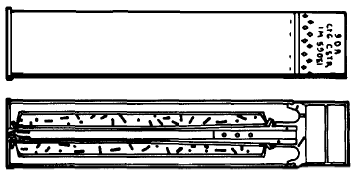 The M590 cartridge is designed for close-in defense against massed attacks on personnel positions.
WARNING: Canister may not be fired overhead of friendly troops.
The M590 cartridge is designed for close-in defense against massed attacks on personnel positions.
WARNING: Canister may not be fired overhead of friendly troops.
- The cartridge consists of an aluminum cartridge case crimped to an aluminum canister filled with 2,400 steel flechettes.
The cartridge case is unperforated and the base contains a rupture disk. A percussion primer is assembled through the
rupture disk into a perforated flash tube that is threaded into the base of the canister.
- The flechettes are 8 grain (0.52 g), low-drag, fin-stabilized, steel-wire projectiles.
- The cartridge case is filled with double-base propellant in a silk bag arranged around the primer tube.
- The canister projectile has a blunt forward end and a heavy aluminum base with three bleed holes to the cartridge case.
The sides are scored to facilitate splitting when the round is fired.
The primer ignites the propellant when struck by the firing pin of the weapon. The burning propellant generates rapidly expanding
gases to propel the canister out of the barrel. Recoil is minimized by blowout of the rupture disk in the base and controlled
pressure release through apertures in the breechblock. At the same time, the bleed holes in the canister base permit gas pressure
to build up inside the canister.
When the projectile leaves the muzzle, the pressure ruptures the canister along the score marks to release the flechettes.
- Fuze, PIBD, M530
-
The point-initiating, base-detonating fuze M530 series includes an inertia-operated graze system. The fuze is armed by setback
through a delay system. On impact, a piezoelectric crystal in nose of projectile generates electrical energy that is transmitted
by wire to the fuze. When HEAT cartridge M371 series is used against troops, the fuze is inertia-actuated by a stab primer when it
strikes the ground or any other object.
The fuze is fitted with a booster, a component of the fuze assembled to it at time of manufacture. Due to location in projectile,
the fuze is not visible in complete round.
- Fuze, PIBD, M530A1
-
The fuzes M530 and M530A1 are essentially alike, differing only in a mechanical escapement device which slows the action of arming
rotor thus providing a longer arming delay.
The M67 can be fired from the ground, using the bipod or the monopod, or from the shoulder. The most stable firing position is the
prone position.
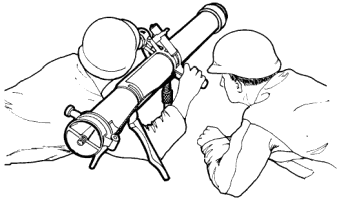
Ground-fired position
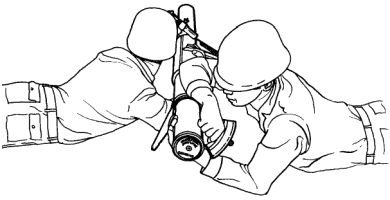
Ground-fired loading position
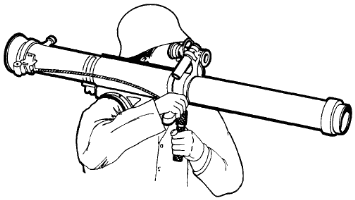
Shoulder-fired position



 The cartridge resembles 90mm HEAT round M371A1 and has similar ballistic characteristics, except that the high explosive filler
is replaced with inert material of the same weight.
The cartridge resembles 90mm HEAT round M371A1 and has similar ballistic characteristics, except that the high explosive filler
is replaced with inert material of the same weight.

 The primer ignites the propelling charge when struck by the firing pin of the weapon. The burning propellant generates rapidly
expanding gases to propel the projectile out of the barrel and to the required velocity. Recoil is minimized by blowout of the
rupture disk and controlled pressure relief through apertures in the breechblock.
The primer ignites the propelling charge when struck by the firing pin of the weapon. The burning propellant generates rapidly
expanding gases to propel the projectile out of the barrel and to the required velocity. Recoil is minimized by blowout of the
rupture disk and controlled pressure relief through apertures in the breechblock.
 The M590 cartridge is designed for close-in defense against massed attacks on personnel positions.
WARNING: Canister may not be fired overhead of friendly troops.
The M590 cartridge is designed for close-in defense against massed attacks on personnel positions.
WARNING: Canister may not be fired overhead of friendly troops.



